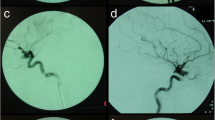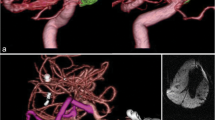Abstract
We report clinical and angiographic findings in eight patients treated by the endovascular approach for an intracranial aneurysm remnant after incomplete surgical clipping. They were seven women and one man, mean age 38 years (range 14–50 years). In three, the remnant was responsible for a recurrent subarachnoid haemorrhage. All were treated by embolisation of the remnant using Guglielmi detachable coils. In two, a nondetachable balloon was inflated in front of the remnant during coil detachment because of a wide neck. Mean clinical and imaging follow-up was 19 months (range 12–24 months). Immediate angiography showed complete occlusion of the remnant and follow-up clinical examination showed good or excellent recovery in all patients. Imaging follow-up confirmed persistent occlusion of the remnant in all cases.

Similar content being viewed by others
References
Batjer HH, Samson DS (1992) Reoperation for aneurysms and vascular malformations. Clin Neurosurg 39: 140–171
Lin T, Fox AJ, Drake CG (1989) Regrowth of aneurysm sacs from residual neck following aneurysm clipping. J Neurosurg 70: 556–560
Sindou M, Acevedo JC, Turjman F (1998) Aneurysmal remnants after microsurgical clipping: classification and results from a prospective angiographic study (in a consecutive series of 305 operated intracranial aneurysms) Acta Neurochir (Wien) 140: 1153–1159
Thornton J, Bashir Q, Aletich VA, Debrun GM, Ausman JI, Charbel FT (2000) What percentage of surgically clipped aneurysms have residual necks ? Neurosurgery 46: 1294–1300
David CA, Vishteh AG, Spetzler RF, Lemole M, Lawton MT, Partovi S (1999) Late angiographic follow-up review of surgically treated aneurysms. J Neurosurg 91: 396–401
Le Roux PD, Elliott JP, Eskridge JM, Cohen W, Winn HR (1998) Risks and benefits of diagnostic angiography after aneurysm surgery: a retrospective analysis of 597 studies. Neurosurgery 42: 1248–1254
Rauzzino MJ, Quinn CM, Fisher WS III (1998) Angiography after aneurysm surgery: indications for “selective” angiography. Surg Neurol 49: 32–41
Ebina K, Suzuki M, Andoh A, Saitoh K, Iwabuchi T (1982) Recurrence of cerebral aneurysm after initial neck clipping. Neurosurgery 11: 764–768
Drake CG, Vanderlinden RG (1967) The late consequences of incomplete surgical treatment of cerebral aneurysms. J Neurosurg 27: 226–238
Sakaki T, Takeshima T, Tominaga M, Hashimoto H, Kawaguchi S (1994) Recurrence of ICA-PcoA aneurysms after neck clipping. J Neurosurg 80: 58–63
MacDonald RL, Wallace C, Kestle JR (1993) Role of angiography following aneurysm surgery. J Neurosurg 79: 826–832
Feuerberg I, Lindquist C, Lindqvist M, Steiner L (1987) Natural history of postoperative aneurysm rests. J Neurosurg 66: 30–34
Drake CG, Friedman AH, Peerless SJ (1984) Failed aneurysm surgery: reoperation in 115 cases. J Neurosurg 61: 848–856
Drake CG, Allcock JM (1973) Postoperative angiography and the “slipped” clip. J Neurosurg 39: 683–689
Giannotta SL, Litofsky NS (1995) Reoperative management of intracranial aneurysms. J Neurosurg 83: 387–393
Allcock JM, Drake CG (1963) Postoperative angiography in cases of ruptured intracranial aneurysms. J Neurosurg 20: 752–759
Rabinstein AA, Nichols DA (2002) Endovascular coil embolization of cerebral aneurysm remnants after incomplete surgical obliteration. Stroke 33: 1809–1815
Thielen KR, Nichols DA, Fulgham JR, Piepgras DG (1997) Endovascular treatment of cerebral aneurysms following incomplete clipping. J Neurosurg 87: 184–189
Bendok BR, Ali MJ, Malisch TW, Russell EJ, Batjer HH (2002) Coiling of cerebral aneurysm remnants after clipping. Neurosurgery 51: 693–697
Hunt W, Hess R (1968) Surgical risk as related to time of intervention in the repair of intracranial aneurysms. J Neurosurg 28: 14–20
Guglielmi G, Viñuela F, Dion J, Duckwiler G (1991) Electrothrombosis of saccular aneurysms via endovascular approach. Part 2: Preliminary clinical experience. J Neurosurg 75: 8-14
Guglielmi G, Viñuela F, Duckwiler G, et al (1992) Endovascular treatment of posterior circulation aneurysms by electrothrombosis using electrically detachable coils. J Neurosurg 77: 515–524
Viñuela F, Duckwiler G, Mawad M (1997) Guglielmi detachable coil embolization of acute intracranial aneurysms: perioperative anatomical and clinical outcome in 403 patients J Neurosurg 86: 475–482
Moret J, Cognard C, Weill A, Castings L, Rey A (1997) The “remodelling technique” in the treatment of wide neck intracranial aneurysms: angiographic results and clinical follow-up in 56 cases. Intervent Neuroradiol 3: 21–35
Jennett B, Bond M (1975) Assessment of outcome after severe brain damage. A practical scale. Lancet i: 480–484
Nanda A, Willis B, Vannemreddy P (2002) Selective intraoperative angiography in intracranial aneurysm surgery: intraoperative factors associated with aneurysmal remnants and vessel occlusions. Surg Neurol 58: 309–315
Barrow DL, Boyer KL, Joseph GJ (1992) Intraoperative angiography in the management of neurovascular disorders. Neurosurgery 30: 153–159
Sato S, Suzuki J (1971) Prognosis in cases of intracranial aneurysm after incomplete direct operations. Acta Neurochir (Wien) 24: 245–252
Ferguson GC (1972) Physical factors in the initiation, growth, and rupture of human intracranial saccular aneurysms. J Neurosurg 37: 666–667
Ostergaard HOG Jr (1985) Incidence of multiple intracranial aneurysms. Influence of arterial hypertension and gender. J Neurosurg 63: 49–55
Ross IB, Weill A, Piotin M, Moret J (2000) Endovascular treatment of distally located giant aneurysms. Neurosurgery 47: 1147–1152
Gruber A, Killer M, Bavinzski G, Richling B (1999) Clinical and angiographic results of endosaccular coiling treatment of giant and very large intracranial aneurysms: A 7-year, single-center experience. Neurosurgery 45: 793–800
Bavinzski G, Killer M, Ferraz-Leite H, Gruber A, Gross CE, Richling B (1998) Endovascular therapy of idiopathic cavernous aneurysms over 11 years. AJNR 19: 559–565
Author information
Authors and Affiliations
Corresponding author
Rights and permissions
About this article
Cite this article
Lubicz, B., Leclerc, X., Gauvrit, J.Y. et al. Endovascular treatment of remnants of intracranial aneurysms following incomplete clipping. Neuroradiology 46, 318–322 (2004). https://doi.org/10.1007/s00234-004-1165-7
Received:
Accepted:
Published:
Issue Date:
DOI: https://doi.org/10.1007/s00234-004-1165-7




